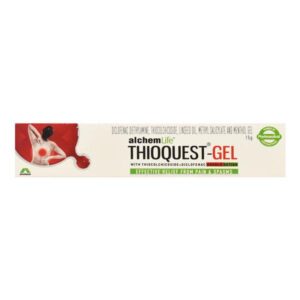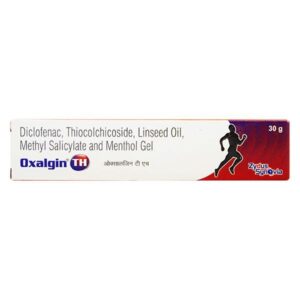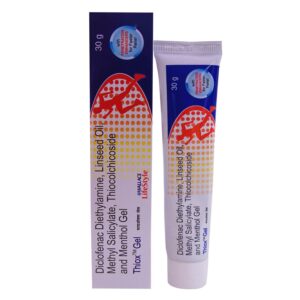DICLOFENAC + LINSEED OIL + MENTHOL + METHYL SALICYLATE + THIOCOLCHICOSIDE
Diclofenac: Diclofenac is a nonsteroidal anti-inflammatory drug (NSAID) that is commonly used to reduce pain and inflammation in conditions such as rheumatoid arthritis, osteoarthritis, ankylosing spondylitis, and gout. It is available in different forms, including oral tablets, capsules, and topical gel.
The mechanism of action of diclofenac involves inhibiting the synthesis of prostaglandins, which are responsible for inflammation, pain, and fever. By doing so, diclofenac helps to relieve pain and reduce inflammation at the site of injury or inflammation.
The dosage and administration of diclofenac can vary depending on the specific condition being treated. For oral tablets, the usual starting dose for adults is 50 mg two to three times a day, depending on the severity of pain. The maximum daily dose should not exceed 150 mg. The extended-release tablets are generally taken once daily.
As for the topical gel, a thin layer is usually applied to the affected area and gently rubbed into the skin. The gel is typically applied two to four times per day, with the frequency depending on the severity of symptoms.
Common side effects of diclofenac include gastrointestinal symptoms like nausea, vomiting, stomach pain, and diarrhea. It may also cause dizziness, drowsiness, headaches, and skin reactions such as rash or itching. In rare cases, diclofenac can lead to more serious side effects such as gastrointestinal bleeding or renal (kidney) dysfunction.
Patients with a history of gastrointestinal bleeding, liver or kidney disease, or cardiovascular problems should use diclofenac with caution and under medical supervision. It is important to follow the prescribed dosage and duration of treatment to minimize the risk of side effects.
Diclofenac should not be used by individuals who are allergic to NSAIDs, are in the last trimester of pregnancy, or have a history of asthma attacks, allergic reactions, or heart failure triggered by NSAIDs.
As with any medication, it is essential to consult with a healthcare professional or read the package insert for specific information and guidance regarding the use of diclofenac, including instructions on dosage and potential drug interactions.
Linseed Oil: Linseed oil is a dietary supplement that is derived from the seeds of the flax plant (Linum usitatissimum). It is also known as flaxseed oil or flax oil. Linseed oil is widely used for its nutritional and medicinal properties.
The primary use of linseed oil is as a source of omega-3 fatty acids, specifically alpha-linolenic acid (ALA). Omega-3 fatty acids are essential for various bodily functions and have been linked to numerous health benefits. Linseed oil is commonly taken to support heart health, promote healthy brain function, reduce inflammation, improve skin health, and enhance immune function.
The mechanism of action of linseed oil is primarily attributed to its high content of ALA, which is converted into eicosapentaenoic acid (EPA) and docosahexaenoic acid (DHA) in the body. EPA and DHA are well-known omega-3 fatty acids that have been extensively studied for their positive effects on the cardiovascular system, brain function, and overall health.
The recommended dose of linseed oil varies depending on the individual’s specific health needs and the concentration of omega-3 fatty acids in the supplement. Generally, the suggested daily intake ranges from 1-2 tablespoons (15-30 mL) of pure linseed oil per day. It is important to follow the dosage instructions provided by the manufacturer or consult a healthcare professional for personalized advice.
Although linseed oil is generally considered safe for most individuals when consumed in moderate amounts, it can cause some side effects. The most common side effects include bloating, stomach discomfort, diarrhea, and nausea. Some individuals may also experience allergic reactions, such as skin rashes or itching, after consuming linseed oil. Additionally, linseed oil has a mild blood-thinning effect, so it is recommended to exercise caution if taking anticoagulant medications or have a bleeding disorder.
As with any dietary supplement, it is essential to consult a healthcare professional before starting linseed oil to determine the appropriate dosage and ensure it does not interfere with any existing health conditions or medications.
Menthol: Menthol is a naturally occurring compound derived from the leaves of the mint plant. It is commonly used as a topical analgesic and is found in many over-the-counter products such as cough drops, nasal sprays, and topical creams.
Menthol works by producing a cooling sensation when applied to the skin or mucous membranes. It does this by activating specific cold receptors called TRPM8 receptors, which then send signals to the brain to produce a cooling effect. This cooling sensation helps to alleviate pain, itching, and irritation.
For topical use, Menthol is typically applied directly to the affected area. The recommended dose and frequency of use may vary depending on the product and the condition being treated. It is important to read and follow the instructions provided with the specific product.
Common side effects of Menthol include mild skin irritation, redness, and a warming sensation. In rare cases, it may cause allergic reactions such as rash, itching, or swelling. If any severe or persistent side effects occur, it is recommended to discontinue use and consult a healthcare professional.
While Menthol is generally considered safe for most people when used as directed, it is important to note that it should not be ingested or applied to broken or damaged skin as it may cause further irritation or adverse effects. It is always advisable to consult with a healthcare professional or pharmacist before using Menthol, especially if you have any underlying medical conditions or are taking other medications.
Methyl Salicylate: Methyl Salicylate is a medication commonly used as a topical analgesic and rubefacient. It is often found in over-the-counter creams, ointments, and liniments used for relieving muscle and joint pain.
The primary mechanism of action of Methyl Salicylate is its ability to produce a cooling sensation on the skin, which helps to alleviate pain and reduce inflammation. It is thought to work by inhibiting certain enzymes involved in the synthesis of prostaglandins, which are chemicals in the body that contribute to pain and inflammation.
When used topically, Methyl Salicylate is applied directly to the affected area and gently massaged into the skin until fully absorbed. The specific dose and frequency of application may vary depending on the brand and formulation of the product, so it is important to read and follow the instructions provided. It is generally recommended to use the minimum effective dose and avoid applying Methyl Salicylate to broken or irritated skin.
Common side effects of Methyl Salicylate may include mild skin irritation, redness, or rash at the application site. Some individuals may also experience an allergic reaction, characterized by symptoms such as itching, swelling, or difficulty breathing. If these side effects occur, it is important to discontinue use and seek medical attention.
Additionally, Methyl Salicylate should be used with caution in individuals who are allergic to salicylates (aspirin), as well as those with asthma, blood clotting disorders, or stomach ulcers. It is also recommended to avoid inhaling or consuming Methyl Salicylate, as it can be toxic if ingested in large amounts.
Overall, Methyl Salicylate is a topical analgesic commonly used for muscle and joint pain relief. Although it is generally well-tolerated, it is important to use it as directed and be aware of potential side effects or interactions with other medications.
Thiocolchicoside: Thiocolchicoside is a muscle relaxant medication primarily used to treat muscle spasms and pain. It is commonly prescribed in conditions such as muscle sprains, strains, and musculoskeletal injuries.
The mechanism of action of thiocolchicoside involves its ability to bind to the gamma-aminobutyric acid (GABA) receptors in the central nervous system. This binding enhances the inhibitory effects of GABA, leading to muscle relaxation and reduction in pain. Additionally, thiocolchicoside also exhibits anti-inflammatory properties, which may contribute to its therapeutic effects.
The recommended dose of thiocolchicoside varies depending on the severity and nature of the condition being treated, as well as individual patient characteristics. It is typically taken orally in the form of tablets or capsules. The usual starting dose is 8-16 mg per day, divided into 2-3 doses. However, your doctor will determine the appropriate dosage for you based on your specific needs.
As with any medication, thiocolchicoside can cause side effects. Common side effects may include dizziness, drowsiness, headache, nausea, and stomach upset. These side effects are usually mild and transient. However, if these symptoms persist or worsen, it is important to seek medical attention. In rare cases, more severe side effects such as allergic reactions, difficulty breathing, and liver problems may occur. If you experience any of these symptoms, you should seek immediate medical help.
It is important to note that thiocolchicoside should not be used as a standalone treatment for musculoskeletal conditions. It is typically prescribed as part of a comprehensive treatment plan that includes rest, physical therapy, and other measures to promote healing and relieve pain. Always follow your doctor’s instructions and inform them about any other medications you may be taking to avoid any potential interactions or complications.




